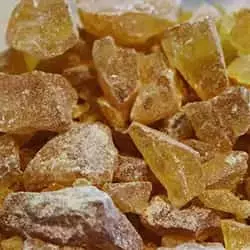IUPAC Name
(4aR)-1,4a-dimethyl-7-propan-2-yl-2,3,4,4b,5,6,10,10a-octahydrophenanthrene-1-carboxylic acid
Cas Number
8050-09-7
HS Code
3806.10.00
Formula
C20H30O2
Appearance
Slightly Yellow Cristal
Common Names
Gum Rosin Grade X
Packaging
80 DRUM (240 kg) TOTAL N.W 19200 kg
Gum Rosin (GR) is product consisting essentially of a mixture of gum and resin usually obtained by making an incision in a plant and allowing the juice which exudes to solidify. GR also is a nonvolatile component of crude gum which is included largely in plants belonging to pine family (Pinaceae). It mainly consists of a various isomer technically called resin acids.
Gum Rosin is produced from the crude pine resin collected from pine trees. The resin is subjected to distillation and the distillation process is carried out in large copper stills. The volatile liquid terpene components would separate from the mixture as it vaporizes at a temperature between 100 to 160°C, leaving behind fluid rosin as the distillate. This fluid rosin is collected and purified by passing it through straining wadding. The condensate left behind is called turpentine oil.
Adhesive Agent
Gum rosin is a key ingredient in the formulation of adhesives, such as hot melt adhesives and pressure-sensitive adhesives. It provides tackiness and bonding strength in various applications, including packaging, woodworking, and automotive.
Paint Ink Coating
Rosin is used in the manufacturing of printing inks, especially in the production of newsprint and packaging inks. It helps improve the ink's adhesion and drying properties. It is also used in the formulation of varnishes, paints, and coatings to enhance adhesion, gloss, and durability. Rosin esters, derived from gum rosin, are commonly employed as binders in these applications.
Textile
In textile manufacturing, gum rosin is used as a sizing agent to improve the smoothness and strength of the fabric.
Pulp and Paper
It is used in the paper industry to increase the paper's strength and as a sizing agent. Rosin sizing agents make paper more resistant to water penetration.
Rubber Gum
Rosin is used as a softening and reinforcing agent in the production of rubber goods and tires. It improves the elasticity and resilience of rubber compounds.
Soap and Detergent
Rosin-based soaps are used in laundry and cleaning products as surfactants and stabilizers. They help maintain the stability and consistency of the product.
Aromatic, Flavours and Fragrances
It is recommended to utilize it as the primary ingredient in bubble and chewing gum. Additionally, it can be utilized in adhevies and as an emulsion stabilizer for flavor and beverage goods. It also serves as an alternative to brominated vegetable oil in citrus oil flavored soft drinks.
